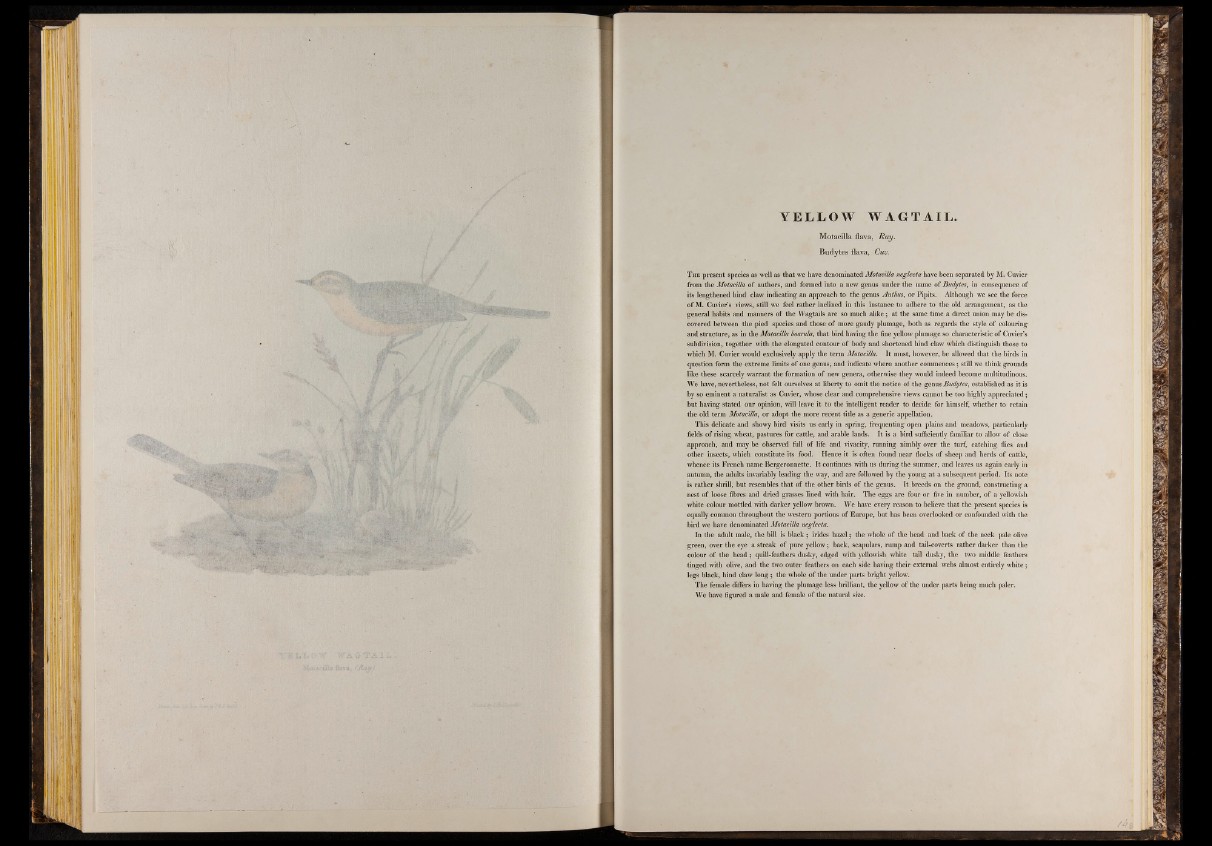
■
Y E L L OW WA G T A I L .
Motacilla flava, Ray.
Budytes flava, Guv.
The present species as well as that we have denominated Motacilla neglecta have been separated by M. Cuvier
from the Motacilla of authors, and formed into a new genus under the name of Budytes, in consequence of
its lengthened hind claw indicating an approach to the genus Anthus, or Pipits. Although we see the force
of M. Cuvier’s views, still we feel rather inclined in this instance to adhere to the old arrangement, as the
general habits and manners of the Wagtails are so much alike; at the same time a direct union may be discovered
between the pied species and those of more gaudy plumage, both as regards the style of colouring
and structure, as in the Motacilla boarula, that bird having the fine yellow plumage so characteristic of Cuvier’s
subdivision, together with the elongated contour of body and shortened hind claw which distinguish those to
which M. Cuvier would exclusively apply the term Motacilla. It must, however, be allowed that the birds in
question form the extreme limits of one genus-, and indicate where another commences; still we think grounds
like these scarcely warrant the formation of new genera, otherwise they would indeed become multitudinous.
We have, nevertheless, not felt ourselves at liberty to omit the notice of the genus Budytes, established as it is
by so eminent a naturalist as Cuvier, whose clear and comprehensive views cannot be too highly appreciated;
but having stated our opinion, will leave it to the intelligent reader to decide for himself, whether to retain
the old term Motacilla, or adopt the more recent title as a generic appellation.
This delicate and showy bird visits us early in spring, frequenting open plains and meadows, particularly
fields of rising wheat, pastures for cattle, and arable lands. It is a bird sufficiently familiar to allow of close
approach, and may be observed full of life and vivacity, running nimbly over the turf, catching flies and
other insects, which constitute its food. Hence it is often found near flocks of sheep and herds of cattle,
whence its French name Bergeronnette. It continues with us during the summer, and leaves us again early in
autumn, the adults invariably leading the way, and are followed by the young at a subsequent period. Its note
is rather shrill, but resembles that of the other birds of the genus. It breeds on the ground, constructing a
nest of loose fibres and dried grasses lined with hair. The eggs are four or five in number, of a yellowish
white colour mottled with darker yellow brown. We have every reason to believe that the present species is
equally common throughout the western portions of Europe, but has been overlooked or confounded with the
bird we have denominated Motacilla neglecta.
In the adult male, the bill is black ; irides hazel; the whole of the head and back of the neck pale olive
green, over the eye a streak of pure yellow; back, scapulars, rump and tail-coverts rather darker than the
colour of the head; quill-feathers dusky, edged with yellowish white tail dusky, the two middle feathers
tinged with olive, and the two outer feathers on each side having their external webs almost entirely white;
legs black, hind claw long; the whole of the under parts bright yellow.
The female differs in having the plumage less brilliant, the yellow of the under parts being much paler.
We have figured a male and female of the natural size.